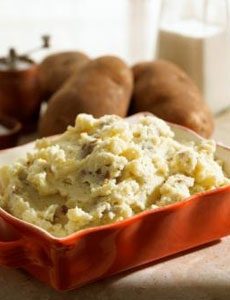January 4, 2012 at 11:29 am
· Filed under Low Calorie, Recipes, Vegetables-Salads-Herbs
|

Healthier mashed potatoes. Photo courtesy
U.S. Potato Board.
|
|
To eat better in the new year, here’s an alternative for healthier mashed potatoes. Use one or all of the tips; play around with different variations to see what you like best:
Use half boiled or steamed potatoes, half steamed cauliflower. The recipe is also known as cauliflower mashed potatoes. Mashed cauliflower looks like mashed potatoes, and is a mom’s trick to get kids (and reluctant adults) to eat their veggies. Sneak it into your mashed potatoes and save calories (plain boiled potatoes have 136 calories per cup, cauliflower just 25 calories). You’ll also get a better blend of nutrients: Both foods are rich in dietary fiber and vitamin C; potatoes are also rich in potassium and vitamin B6. Cauliflower offers a richer nutrient profile including manganese, pantothenic acid, phosphorus, potassium, protein, riboflavin, thiamin and vitamins B6, B9 (folate) and K.
Keep the skin on the potatoes. The skin contains approximately half of a potato’s total dietary fiber and nutrients. The fiber is an important addition to your recommended daily intake of 42g of fiber (here’s why), and fiber makes you feel fuller.
|
|
Reduce the butter. Use whipped butter instead of solid butter sticks: It contains more air and thus fewer calories. We use half butter and half basil olive oil. Any flavored or regular olive oil will do, but use extra virgin olive oil—the better the oil, the better the taste.
Use nonfat milk. Instead of whole milk or half and half, use nonfat milk. We use the Skim Plus Milk from Farmland Dairies, which is 0% fat but as rich as 2% milk because extra milk protein is added, thickening the milk and concentrating the flavor. (It’s therefore more expensive, but well worth it). Each regional dairy has a different name for this type of product, and it’s not necessarily the most logically descriptive. For example, another brand in our area, Tuscan Dairy Farms, calls its concentrated nonfat milk “Over The Moon.” If you can’t find this type of milk, ask your grocer to point out the “extra rich nonfat milk.”
Replace sour cream with fat-free sour cream or nonfat Greek yogurt. We don’t ordinarily use sour cream in our mashed potatoes, but know quite a few people who do. We tested the recipe with both fat-free sour cream and nonfat Greek yogurt. We preferred the yogurt.
Use sea salt instead of regular table salt. They have the same basic nutritional value, but sea salt has a better flavor and texture. It’s also a natural product, produced through evaporation of seawater with little processing, so the trace minerals and elements from the water remain (providing the flavor and color). Table salt is mined from underground salt deposits, then heavily processed to eliminate all the minerals.
Add fresh herbs for flavor. We love to snip fresh herbs into our mashed potatoes. Basil, chives and parsley are personal favorites—singly or together. They bring such sprightly flavor notes that no one will notice that far fewer creamy fats—butter, sour cream and/or whole milk—are there. A grind of fresh pepper completes the new recipe.
Please share your own tips and tricks.
|
Please follow and like us:
Permalink
Comments are closed.